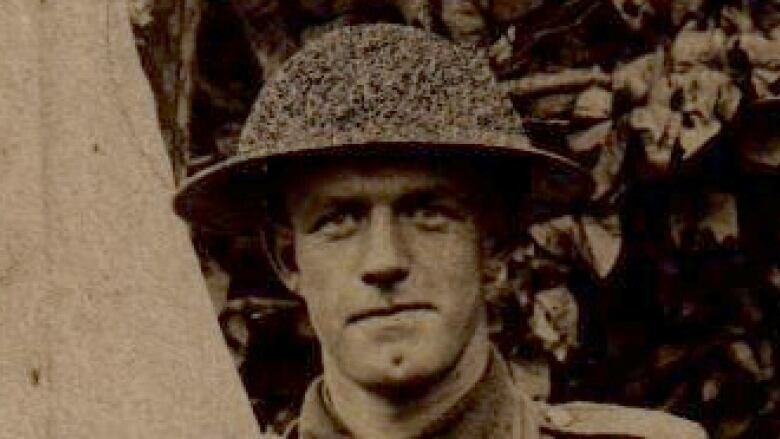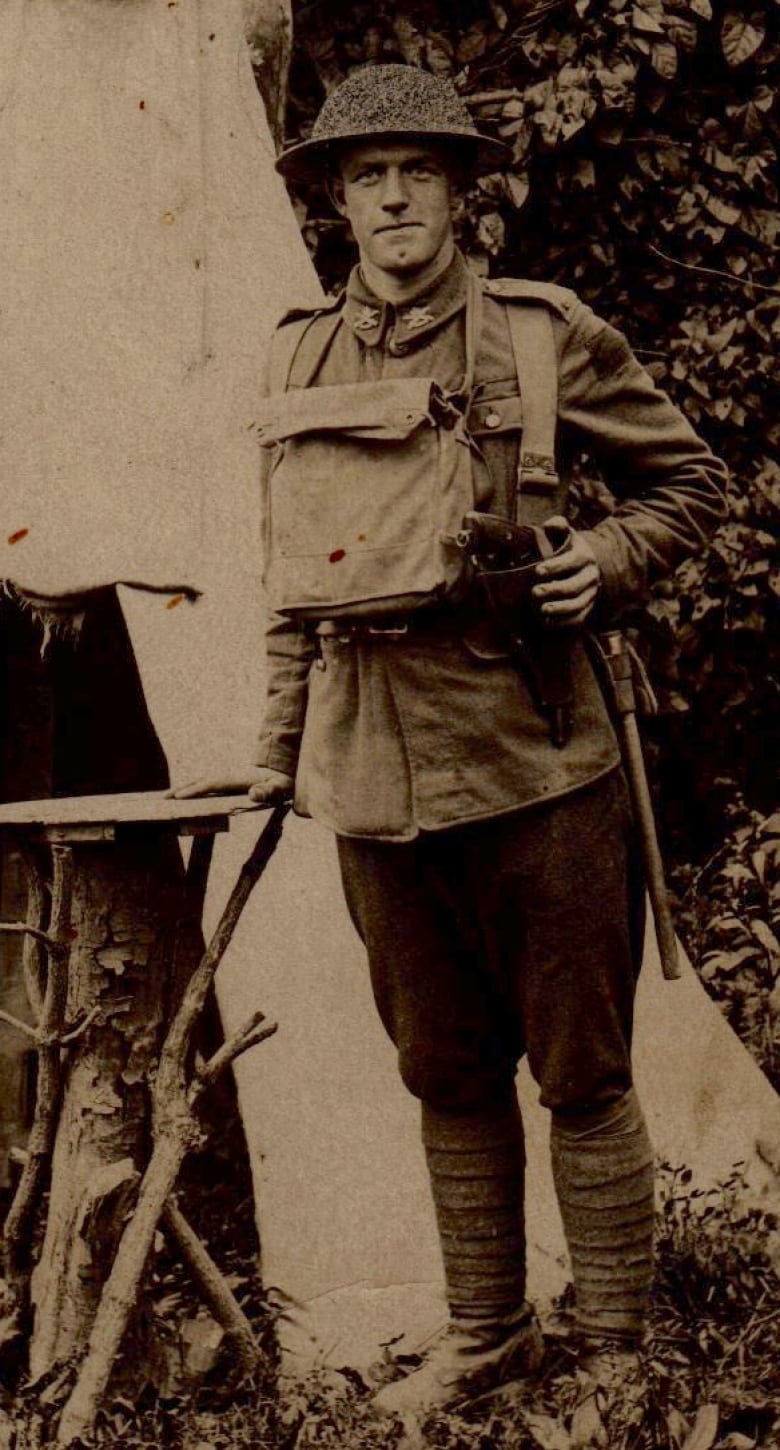Remembrance Day: A Machine Age warrior's story
Foster Smith survived his time in a WWI machine gun unit, but remained an unknown soldier to his family

Of the many modern marvels of London, England, in 1916, few things impressed Pte. Foster Albert Smith of Danville, Quebec, like his first encounter with an escalator.
"I got on a pair of steps leading to the underground railway this a.m., and when I got on the top step they started to move and I stood on the top step and it took me to the bottom. I was quite surprised to have a ride on a flight of stairs," he reported to his youngest sister Grace in a letter back home dated Sept. 9.
My grandfather's encounter with an escalator was just the start of his education over the next two years on the mind-boggling potential of modern machinery.
That understanding was about to deepen significantly on the battlefields of the Western Front, where he served with the Canadian Machine Gun Corps.
- DIGITAL ARCHIVES:The First World War: Canada Remembers
- Rezori: The true cost of the First World War
- George Lawrence Price was last Canadian soldier killed in First World War
- WW I Canadian soldier's remains identified
Mystery of wartime service
Before thisyear, I knew little about Foster's experiences in the First World War. He died at the age of 69, six years before I was born, and everyone assumed the story of his wartime service died with him.
Then my sister took up investigating my dad's family tree, and her path led to a request for Foster's war service record from the Library and Archives of Canada.
A month later, she was emailed a 40 page file, and the question mark that was Foster Smith's First World War and his possible reasons for keeping it to himself soon became terribly clear.
The 117th Eastern Townships Battalion
Foster was 19 when he volunteered on Nov. 12, 1915, for overseas service with the newly created 117th Eastern TownshipsBattalion at the unit's recruiting station in Sherbrooke.
According to battalion historian Craig Meyers, the unit was given the name Eastern Townships Battalion to inspire local pride,and it worked.
Foster and his brother Roy were two of 1,278 Eastern Townships men who joined the 117th by the summer of 1916. Farmers like Foster and his brother figured prominently among the mix of English-Canadian, French-Canadian and British nationals it attracted.
After basic training at Valcartier, the 117th set sail for England on August 14, 1916, aboard the Empress of Britain and arrived at Liverpool 10 days later.
Within three months of its arrival, however, military authorities decided the inexperienced 117th would be put to better use reinforcing battle-hardened units already fighting in France.
Despite an indignant uproar back in Quebec, the Eastern Townships Battalion was dismantled without ever seeing action at the front.

Deadlyfrontlinerole
Foster's war record shows that he was transferred to the new Canadian Machine Gun Depot at Crowborough in East Sussex on November 16, 1916.
The creation of the Canadian Machine Gun Depot in the summer of 1916 spoke to the fearsome weapon's dominant and deadly frontline role.
Capable of firing up to 550 rounds per minute, modern machine guns had combined with advancements in artillery and chemical warfare to claim a horrific tollin dead and wounded.
Whether Foster volunteered or was recruited for service with the Canadian Machine Gun Corps is not known. Rumourscirculating among the troops that members of machine gun sections were exempt from guardduties was cause enough for many to volunteer.
Foster finished his training a month after his arrival at Crowboroughand was transferred to the Canadian Machine Gun Pool in December 1916.
His marching orders for France came three months later and hearrived at the pool's camp at Camiers on March 13, 1917.
On April 12, 1917, he was sent to the front as a reinforcement with the 12th Canadian Machine Gun Company.
From Vimy to victory

Three days prior to Foster's arrival at the battlefront,the entry in his unit's war diary for April 9, 1917, succinctly notes: "5:30 a.m.: Successful attack on Vimy Ridge."
The cost of that success to the 170-man company was six menkilled and three officers and 18 men wounded. Another six men were listed as missing.
Foster was sent in to help fill those gaps. In the bloody months ahead, the diary notes hundreds of reinforcements being absorbed into the ranks to replace the dead, the wounded and the sick.
What precise role Foster played with the 12th Canadian Machine Gun Companyis not described in his war service record. However, through the unit's war diaries, the daily trials and unspoken horrors of his war experiences emerge through the facts and figures dutifully noted by the company's main diarist, Maj. L.F. Pearce.
- June 18, 1917: "No 1 gun No 4 section blown to bits by shell fire."
- Oct. 22, 1917: "Much mud and conditions very trying."
- Nov. 1, 1917: "Lieut. Leach was carried out suffering from shell shock and his crew suffered heavy casualties."
- Nov. 2, 1917: "Several men still suffering from effects of hostile gas shelling."
- Nov. 23, 1917: "Rest; Many men footsore and in poor condition."
The war diaries of the 12th Canadian Machine Gun Companyreveal that my grandfather was involvedin every campaign fought by the Canadian Corps from his arrival at the frontto the end of the war.
Lens,Hill 70,Passchendaele,Arras,Amiens,Drocourt-Quant Line,Canal du Nord,Bourlon Wood,Cambrai, ValenciennesFoster managed to survive them all.
That's all the more impressive given his post in themachine gun company, whose lethal teams were often singled out for special attention by German artillery.
If I get back to Canada, I believe I will stay there and roam no more.-Pte. Foster Albert Smith, letter to his sister dated Sept. 9, 1916
In a letter congratulating the MachineGunCorps for itscontributions to the taking of Passchendaele, Canadian Corps Commander Sir Arthur Currie underscored the special courage of its gun crews.
"I regret that the casualties have been so high, but these have resulted from the special efforts made by the enemy to destroy the Machine Gun Crews from whom they have suffered so much," Curriewrote.
"That the men of the Machine Gun Corps kept their guns in action under the conditions experienced, testifies in the highest possible manner to their splendid discipline and fine fighting spirit."
In total, the Canadian Machine Gun Corps suffered 5,777 casualtiesin the First World War a casualty rate of more than one in three.
'He experienced so much sadness'
In his Sept. 9, 1916, letterto his sister Grace from London, Foster wrote, "If I get back to Canada, I believe I will stay there and roam no more."

After the war, he did just that. He returned to the Eastern Townships, where he courted and married Margaret Mary Smith, with whom he had three sons Ross, Desmond and my father, Murdo.
He returned to uniform in World War Two with the Veterans Guard, serving at a prisoner-of-war camp in Gravenhurst, Ontario.
The career civil servant, however, was destined to survive more tragedies. In 1934, Margaret died just after giving birth to Murdo.Twenty years later Ross, 32,succumbedto complications associated with a head wound he received when his tank was hit in the Battle of the Falaise Pocket in Normandy in 1944.
"TheFirst World War and the loss of his wife and eldest son why does one deserve to lose like that," my own father saidof Foster.
"He experienced so much sadness, but I never thought of him as a sad person. I never thought he felt that way, but his life would certainly justify it."
Foster persevered despite it all, makingthe most of the family he still had and his new grandchildren.
Pte. Foster Albert Smith, after all, was nothing if not a survivor.
That we now know with certainty.












_(720p).jpg)


 OFFICIAL HD MUSIC VIDEO.jpg)
.jpg)



























































































